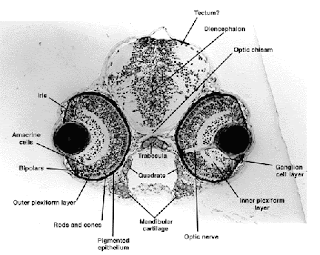Zebrafish (Danio rerio) are probably the most important fish for understanding humans. They are small fish, 2-3 cm long and native to India, Bangladesh, and Pakistan. Most conspicuous about them is the contrasted coloration with alternating blue and white horizontal stripes, even extending onto the caudal fin. That means they are horizontal where zebras are vertical. Otherwise there are no similarities 🙂
Zebrafish occur in many places in India, in the north in the Indus, Ganga, and Brahmaputra as well as in Kerala in the south, but appear uniform in color pattern and other morphology. They live in schools in different habitats, and are often collected in large numbers. As aquarium fish they are hardy, easy to breed, and prolific.
The distinctive colour pattern, which can be genetically altered, ease of keeping, and the fast generation time contribute to zebrafish status as a so-called model organism, which developmental biologists use to study the development and inheritance of various structures. Recently also, zebrafish researchers have been helped by improved understanding of the systematics of the group of fishes to which zebrafish belong, so that structures can be studied comparatively in closely related species.
Here is a dead zebrafish in alcohol from Assam, India. Not very colourful, but useful for taxonomic studies.
I just spent two days writing a description of a new species that I and my student Te Yu Liao collected last year (about this time) in Myanmar. There are many species of fishes closely related to the zebrafish. Thirteen species have been named in the genus Danio, and at least ten more species remain to be described. Most fascinating among the zebrafish relatives, is the leopard danio, which turned up in aquarium circles in Czechoslovakia in the 1960s and was described as a new species with the name Brachydanio frankei. This form, with small dark spots all over the body and fins, has never been found in the wild. It is probably a mutant of zebrafish, differing only in the irregular colour pattern. The genus, however, includes species that are spotted for real.
I will come back to fish species that only exist in the aquarium trade later. Let us round off the day with some zebrafish entertainment.
If you need just an overview of zebrafish, with the basic data, try Fishbase.
Wikipedia insists on being very technical about zebrafish
These developing zebrafish embryos are just irresistible:
The Wolfgang Driever Lab at the University of Freiburg has still images so you can track all the details at different stages. Click the image (from their website) to enter the zebrafish anatomy:
And then there is an enthusiasts’s website with images of various zebrafish-like species, Pete Cottle’s Danios and Devarios.

